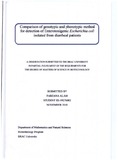| dc.description.abstract | Enterotoxigenic Escherichia coli (ETEC) is one of the main causes of childhood diarrhea
and in travelers in developing countries . ETEC expresses one or both of two different
enterotoxin subtypes : heat-stable toxins (ST), heat-labile toxin (LT) and more than 25
different colonization factors (CFs) that mediate adherence to the intestinal cell wall. A
total number of 3459 stool specimens were tested from patients enrolled in the 2%
routine surveillance system in ICDDR, B during the period of March , 2009 to July, 2010
and 10% (n=364) ETEC strains were detected at the Immunology Laboratory. Genotypic,
multiplex-PCR and phenotypic , GM 1-enzyme-linked immunosorbent assay (GMIELISA)
method were chosen to compare those isolated strains . Immuno Dot blot assay
using specific monoclonal antibodies (MAbs) was done for the detection of colonization
factors (CFs). Thirty strains have shown discrepancy in results among 364 ETEC strains.
In which , 17% (n=5) was positive for heat stable toxin (ST), 10% (n=3) was positive for
the heat labile toxin (LT), and 73% (n=22) was positive for both LT and ST toxin in case
of PCR method but in ELISA, LT was found 17%, ST was 33% and LT/ST was 37%.
About 67% of ETEC strains from stool specimens were colonization factor (CF) positive.
Of these , 40% of LT toxin, 70% of ST toxin and 55 % of LT/ST toxin producing ETEC
strains were CF positive . Among different colonization factors CS5 + CS6 and CS14
were the predominant phenotypes, followed by CS6, CFA/I, CS 17, CS1+CS3+CS21,
CS2+CS3+CS21 in terms of occurrence whereas , CS2 + CS3 expressing ETEC strains
were less frequently isolated from stool specimens . We did not find a very good
similarity in results derived from genotypic and phenotypic methods . About 13% of PCR
positive strains were negative by ELISA among those 30 strains . In PCR, ST was 17%
whereas 33% found in ELISA and LT was 10% by PCR whereas 17% found in ELISA.
In conclusion , we therefore did not find similar rates of LT and ST by the PCR method; it
might due to low concentration of DNA in template that was prepared . It is possible that
either the eltB or estA gene is present as a silent gene or, alternatively , that the levels of
expression of the gene for these toxin are so low that the toxin was not detected by the
ELISA method. Thus in future study, rRT-PCR can be carried out to evaluate genotypic and phenotypic toxin results specificity. | en_US |

